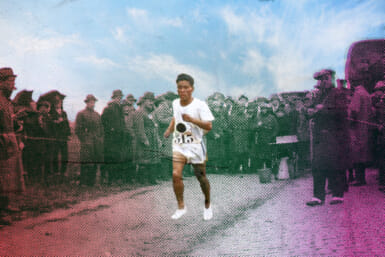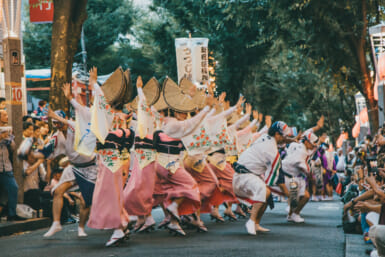by Yurie Horiguchi
Dear Bridges:
I have been in Japan for six months but have only recently begun to notice the different types of kimono worn by ladies here. I find particularly attractive the elegant black kimono worn at weddings, but have seen it worn on no other occasion. Why?
Dear Why:
I really can’t answer that question, except to say that it is a matter of tradition that the ceremonial black kimono with the lower part of the front and back panels printed in beautiful designs, often embroidered over in gold or silver thread, is worn only at wedding ceremonies—and only by married women.
This kimono is called a tome-sode and is imprinted with five family crests, two in front, two on the back of the sleeves and one in the center of the back.
It does seem a pity that such an elegant kimono can only be worn at weddings, especially if one attends only one wedding in a lifetime (which, however, is rare in Japan).
But kimono and especially obi, are, and always have been, a family heritage. There is no history of jewels being passed down from mother to daughter in Japan. Jewellery in the form of precious stones such as diamonds, emeralds, sapphires, etc., are recent introductions to Japan, and even the imperial family has no collection to compare with that of Western royal houses.
The obi therefore and sometimes the kimono, is not only an inheritance but also a negotiable asset. In time of need, it can be sold or pawned. This is what happened during: and after World War II when many priceless obi were sold for a handful of rice.
Young unmarried girls wear very colorful long-sleeved kimono called furi-sode, with the obi tied in the most intricate manner at the back.
This kimono is more economical than the black wedding attire as it can be worn on other ceremonial occasions, such as at New Year’s time, and at graduation and other parties.
The most important furi-sode of all is the bride’s wedding costume.
Kimono worn by married ladies at parties and receptions is called homongi. Great care is taken in chosing the right color for the right age, as well as the right patterned design. In general, the younger the wearer, the brighter the colors and the more vivid the patterns.
When such a kimono becomes “too young” for the wearer, she puts it aside for her daughter.
There is also a special mourning kimono called mofuku which is worn only at funerals and on special family memorial days. It is all black, worn with a black obi and black zori (sandals). Only the neckpiece, the undergarments and the tabi (foot socks) are white.
There is a winter and a summer mofuku. The former is generally of heavy, rich, lined silk, while the latter is unlined and of thin silk or hemp (asa).
The dead are always clothed entirely in white when laid in the coffin.
The ordinary, or every’ day, kimono is never crested, and is generally worn with a haori, a just-below-knee length type of outer garment distinct in color and design from the kimono itself.
Which brings us to the happi which so many tourists and foreigners in Japan delight in buying, believing it to be “typically Japanese.”
It is. In its traditional form it is a typical livery-coat which Japanese carpenters, plasterers, gardeners and other workmen usually wear when plying their trades.
It is also worn by men and young boys participating in a local matsuri, or festival. In the Meiji Era it was worn by rickshaw pullers.
The “happy-coat” that is sold in tourist-trade oriented stores are in silk or synthetic materials with gaily printed designs, and were evolved by GI popular demand during the Occupation, thereafter becoming an export product.
But the “happy-coat” is not the happi. The latter is made of indigo-dyed cotton cloth, with trade crests dyed in white in the center of the back, and the name of the enterprise on the two front lapels. It has a long history, but has always been worn only by laborers.
The yukata Is the popular unlined summer cotton kimono that is worn by both men and women. Traditionally, the yukata for women have large flower or other designs dyed in white on a blue ground, or vice versa. Colors other than white andblue are a recent innovation.
This garment is also worn as a nightgown, or in lieu of pyjamas, so no matter how new or crisp a yukata might be. it Is never worn for making formal calls or receiving visitors.
One of the best places to see not only the evolution of the Japanese kimono over the past two thousand years, but also exquisite modern kimono, is at the Silk House in Yokohama.








